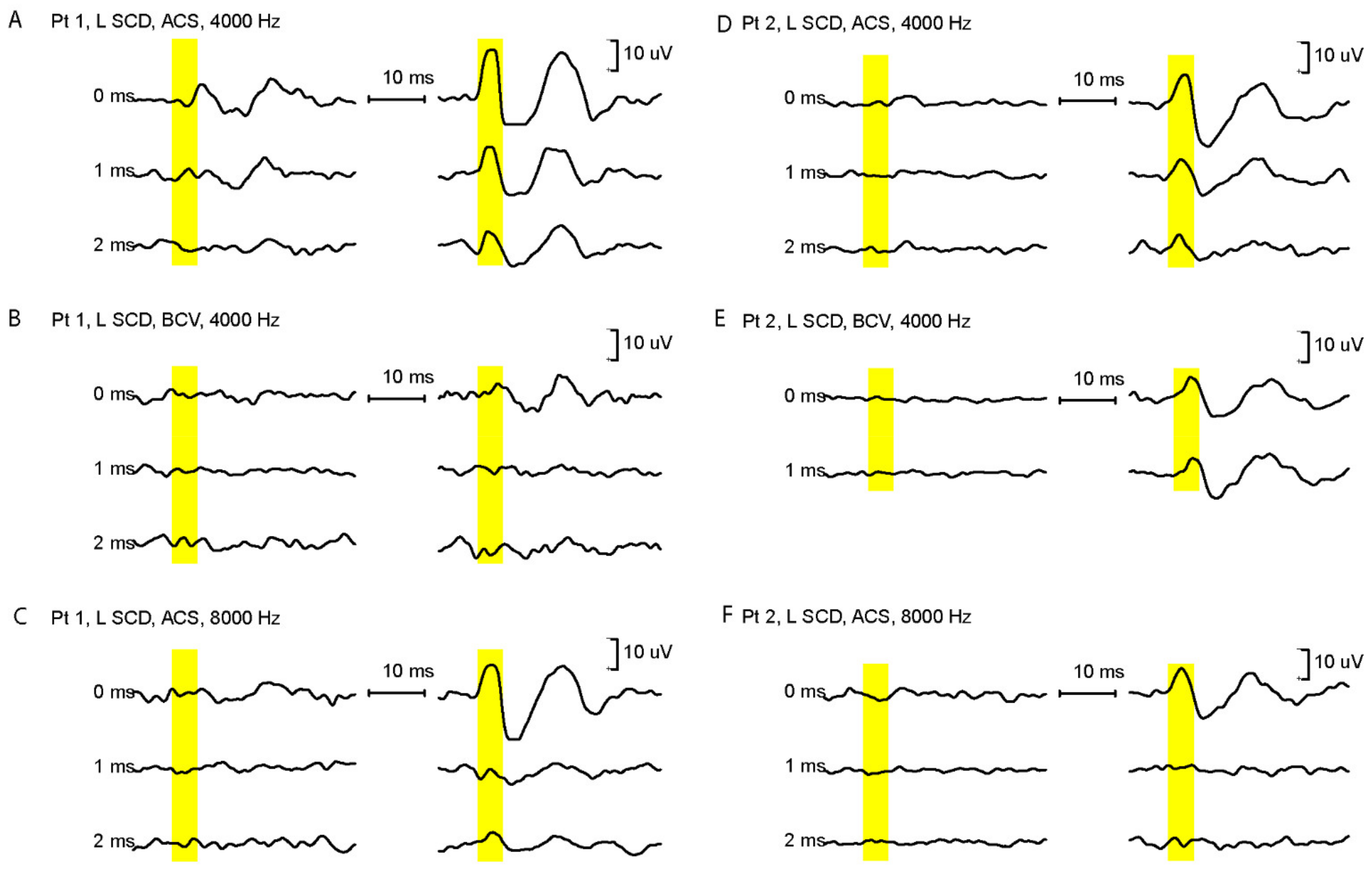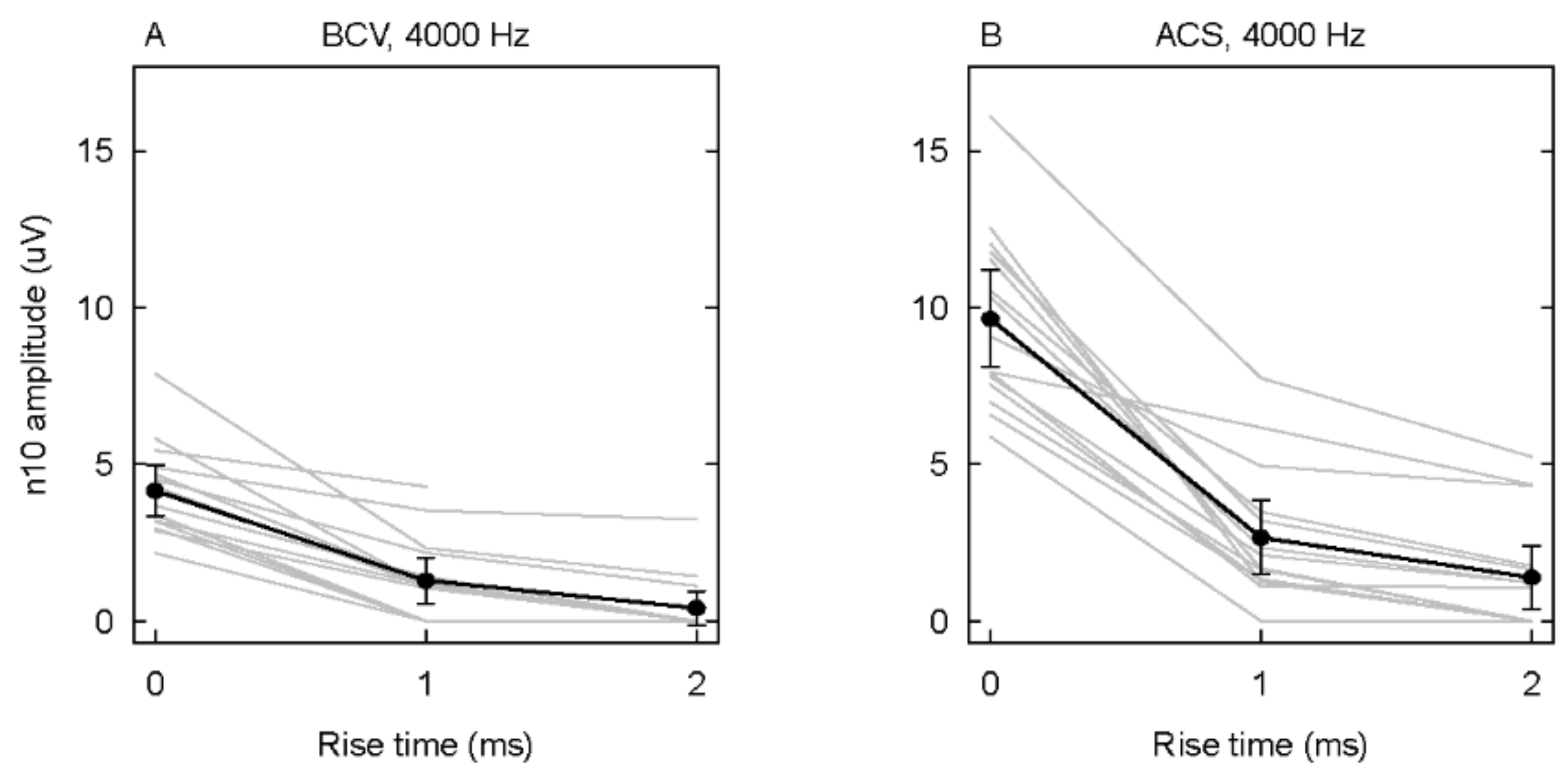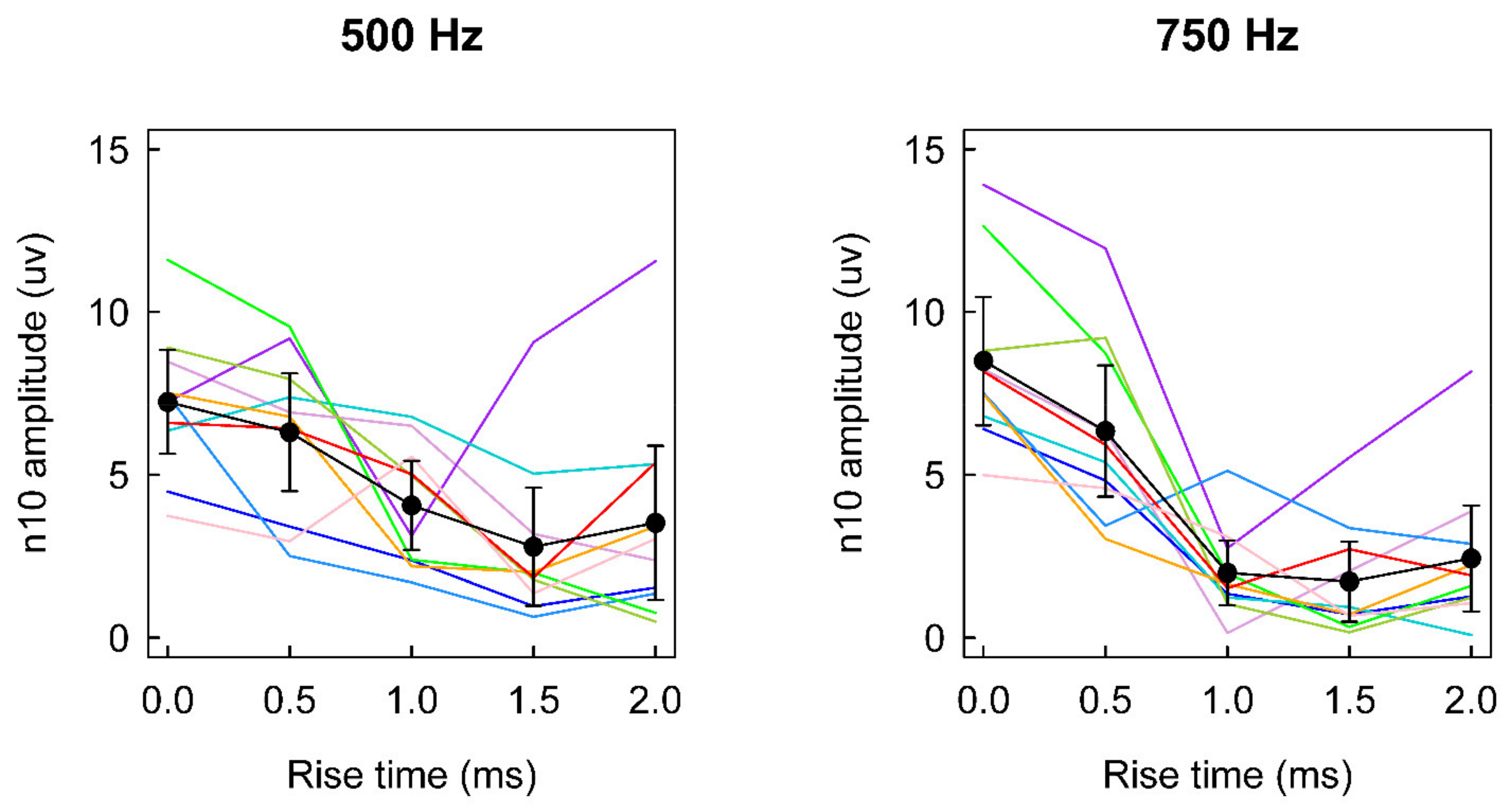A Single Fast Test for Semicircular Canal Dehiscence—oVEMP n10 to 4000 Hz—Depends on Stimulus Rise Time
Abstract
:1. Introduction
2. Materials and Methods
3. Results
4. Discussion
4.1. Clinical Neurophysiology-Healthy Subjects
4.2. The Importance of Stimulus Jerk for VEMPs
4.3. Rise Time in Clinical VEMP Testing
5. Conclusions
Author Contributions
Funding
Institutional Review Board Statement
Informed Consent Statement
Data Availability Statement
Conflicts of Interest
References
- Minor, L.B. Superior canal dehiscence syndrome. Am. J. Otol. 2000, 21, 9–19. [Google Scholar] [CrossRef]
- Minor, L.B. Clinical manifestations of superior semicircular canal dehiscence. Laryngoscope 2005, 115, 1717–1727. [Google Scholar] [CrossRef] [PubMed]
- Wackym, P.A.; Agrawal, Y.; Ikezono, T.; Balaban, C.D. Editorial: Third Window Syndrome. Front. Neurol. 2021, 12, 704095. [Google Scholar] [CrossRef]
- Rosowski, J.J.; Songer, J.E.; Nakajima, H.H.; Brinsko, K.M.; Merchant, S.N. Clinical, experimental, and theoretical investigations of the effect of superior semicircular canal dehiscence on hearing mechanisms. Otol. Neurotol. 2004, 25, 323–332. [Google Scholar] [CrossRef] [PubMed]
- Iversen, M.M.; Zhu, H.; Zhou, W.; Della Santina, C.C.; Carey, J.P.; Rabbitt, R.D. Sound abnormally stimulates the vestibular system in canal dehiscence syndrome by generating pathological fluid-mechanical waves. Sci. Rep. 2018, 8, 10257. [Google Scholar] [CrossRef]
- Colebatch, J.G.; Rosengren, S.M. Investigating short latency subcortical vestibular projections in humans: What have we learned? J. Neurophysiol. 2019, 122, 2000–2015. [Google Scholar] [CrossRef] [PubMed]
- Curthoys, I.S. A critical review of the neurophysiological evidence underlying clinical vestibular testing using sound, vibration and galvanic stimuli. Clin. Neurophysiol. 2010, 121, 132–144. [Google Scholar] [CrossRef] [PubMed]
- Curthoys, I.S.; Grant, J.W.; Burgess, A.M.; Pastras, C.J.; Brown, D.J.; Manzari, L. Otolithic Receptor Mechanisms for Vestibular-Evoked Myogenic Potentials: A Review. Front. Neurol. 2018, 9, 366. [Google Scholar] [CrossRef]
- Curthoys, I.S.; Grant, J.W.; Pastras, C.J.; Brown, D.J.; Burgess, A.M.; Brichta, A.M.; Lim, R. A review of mechanical and synaptic processes in otolith transduction of sound and vibration for clinical VEMP testing. J. Neurophysiol. 2019, 122, 259–276. [Google Scholar] [CrossRef]
- Curthoys, I.S.; Burgess, A.M.; Goonetilleke, S.C. Phase-locking of irregular guinea pig primary vestibular afferents to high frequency (>250 Hz) sound and vibration. Hear. Res. 2019, 373, 59–70. [Google Scholar] [CrossRef]
- Ward, B.K.; Van de Berg, R.; Van Rompaey, V.; Bisdorff, A.; Hullar, T.E.; Welgampola, M.S.; Carey, J.P. Superior semicircular canal dehiscence syndrome: Diagnostic criteria consensus document of the committee for the classification of vestibular disorders of the Barany Society. J. Vestib. Res.-Equilib. Orientat. 2021, 31, 131–141. [Google Scholar] [CrossRef] [PubMed]
- Manzari, L.; Burgess, A.M.; McGarvie, L.A.; Curthoys, I.S. Ocular and cervical vestibular evoked myogenic potentials to 500 Hz Fz bone-conducted vibration in superior semicircular canal dehiscence. Ear Hear. 2012, 33, 508–520. [Google Scholar] [CrossRef] [PubMed]
- Frohlich, L.; Curthoys, I.S.; Kosling, S.; Obrist, D.; Rahne, T.; Plontke, S.K. Cervical and Ocular Vestibular-Evoked Myogenic Potentials in Patients with Intracochlear Schwannomas. Front. Neurol. 2020, 11, 549817. [Google Scholar] [CrossRef] [PubMed]
- Batuecas-Caletrio, A.; Jara, A.; Suarez-Vega, V.M.; Marcos-Alonso, S.; Sanchez-Gomez, H.; Perez-Fernandez, N. Skull Vibration-Induced Nystagmus and High Frequency Ocular Vestibular-Evoked Myogenic Potentials in Superior Canal Dehiscence. Audiol. Res. 2022, 12, 23. [Google Scholar] [CrossRef]
- Manzari, L.; Burgess, A.M.; McGarvie, L.A.; Curthoys, I.S. An Indicator of Probable Semicircular Canal Dehis-cence: Ocular Vestibular Evoked Myogenic Potentials to High Frequencies. Otolaryngol. Head Neck. Surg. 2013, 149, 142–145. [Google Scholar] [CrossRef]
- Curthoys, I.S.; Manzari, L. A simple specific functional test for SCD: VEMPs to high frequency (4,000 Hz) stimuli-their origin and explanation. Front. Neurol. 2020, 11, 612075. [Google Scholar] [CrossRef]
- Noij, K.S.; Rauch, S.D. Vestibular Evoked Myogenic Potential (VEMP) testing for diagnosis of Superior Semicir-cular Canal Dehiscence. Front. Neurol. 2020, 11, 695. [Google Scholar] [CrossRef]
- Noij, K.S.; Remenschneider, A.K.; Herrmann, B.S.; Guinan, J.J.; Rauch, S.D. Optimized Diagnostic Approach to Patients Suspected of Superior Semicircular Canal Dehiscence. Ear Hear. 2021, 42, 1295–1305. [Google Scholar] [CrossRef]
- Tran, E.D.; Swanson, A.; Sharon, J.D.; Vaisbuch, Y.; Blevins, N.H.; Fitzgerald, M.B.; Steenerson, K.K. Ocular Ves tibular-Evoked Myogenic Potential Amplitudes Elicited at 4 kHz Optimize Detection of Superior Semicir-cular Canal Dehiscence. Front. Neurol. 2020, 11, 879. [Google Scholar] [CrossRef]
- Lin, K.; Lahey, R.; Beckley, R.; Bojrab, D.; Wilkerson, B.; Johnson, E.; Bain, S.; Hong, R.S. Validating the Utility of High Frequency Ocular Vestibular Evoked Myogenic Potential Testing in the Diagnosis of Superior Semicircular Canal Dehiscence. Otol. Neurotol. 2019, 40, 1353–1358. [Google Scholar] [CrossRef]
- Iwasaki, S.; Smulders, Y.E.; Burgess, A.M.; McGarvie, L.A.; MacDougall, H.G.; Halmagyi, G.M.; Curthoys, I.S. Ocular vestibular evoked myogenic potentials to bone conducted vibration of the midline forehead at Fz in healthy subjects. Clin. Neurophysiol. 2008, 119, 2135–2147. [Google Scholar] [CrossRef] [PubMed]
- Field, A. Discovering Statistics Using IBM SPSS Statistics, 4th ed.; Sage: London, UK, 2013. [Google Scholar]
- Lim, L.J.Z.; Dennis, D.L.; Govender, S.; Colebatch, J.G. Differential effects of duration for ocular and cervical vestibular evoked myogenic potentials evoked by air- and bone-conducted stimuli. Exp. Brain Res. 2013, 224, 437–445. [Google Scholar] [CrossRef] [PubMed]
- Kantner, C.; Hapfelmeier, A.; Drexl, M.; Gurkov, R. The effects of rise/fall time and plateau time on ocular vestibular evoked myogenic potentials. Eur. Arch. Otorhinolaryngol. 2014, 271, 2401–2407. [Google Scholar] [CrossRef] [PubMed]
- Curthoys, I.S. The new vestibular stimuli: Sound and vibration-anatomical, physiological and clinical evidence. Exp. Brain Res. 2017, 235, 957–972. [Google Scholar] [CrossRef]
- Dlugaiczyk, J.; Burgess, A.M.; Goonetilleke, S.C.; Sokolic, L.; Curthoys, I.S. Superior Canal Dehiscence syndrome: Relating clinical findings with vestibular neural responses from a guinea pig model. Otol. Neurotol. 2019, 40, e406–e414. [Google Scholar] [CrossRef]
- Burgess, A.M.; Mezey, L.E.; Manzari, L.; MacDougall, H.G.; McGarvie, L.A.; Curthoys, I.S. Effect of Stimulus Rise-Time on the Ocular Vestibular-Evoked Myogenic Potential to Bone-Conducted Vibration. Ear Hear. 2013, 34, 799–805. [Google Scholar] [CrossRef]
- Pastras, C.J.; Curthoys, I.S.; Brown, D.J. In vivo recording of the vestibular microphonic in mammals. Hear. Res. 2017, 354, 38–47. [Google Scholar] [CrossRef]
- Jones, T.A.; Jones, S.M.; Vijayakumar, S.; Brugeaud, A.; Bothwell, M.; Chabbert, C. The adequate stimulus for mammalian linear vestibular evoked potentials (VsEPs). Hear. Res. 2011, 280, 133–140. [Google Scholar] [CrossRef]
- Pastras, C.; Curthoys, I.S.; Brown, D. Characteristics of the Mammalian Vestibular Short-Latency Evoked Potential; Association for Research in Otolaryngology: Brentwood, TN, USA, 2022. [Google Scholar]
- Murofushi, T.; Matsuzaki, M.; Wu, C.H. Short tone burst-evoked myogenic potentials on the sternocleidomastoid muscle—Are these potentials also of vestibular origin? Arch. Otolaryngol. Head Neck Surg. 1999, 125, 660–664. [Google Scholar] [CrossRef]
- Fife, T.D.; Colebatch, J.G.; Kerber, K.A.; Brantberg, K.; Strupp, M.; Lee, H.; Walker, M.F.; Ashman, E.; Fletcher, J.; Callaghan, B.; et al. Practice guideline: Cervical and ocular vestibular evoked myogenic potential testing Report of the Guideline Development, Dissemination, and Implementation Subcommittee of the American Academy of Neurology. Neurology 2017, 89, 2288–2296. [Google Scholar] [CrossRef]
- Cremer, P.D.; Minor, L.B.; Carey, J.P.; Della Santina, C.C. Eye movements in patients with superior canal dehiscence syndrome align with the abnormal canal. Neurology 2000, 55, 1833–1841. [Google Scholar] [CrossRef] [PubMed]



| Patient | Gender | Age | Affected Side |
|---|---|---|---|
| 1 | F | 75 | left |
| 2 | M | 75 | right |
| 3 | M | 62 | left |
| 4 | M | 81 | left |
| 5 | M | 51 | right |
| 6 | M | 39 | left |
| 7 | F | 46 | right |
| 8 | M | 32 | right |
| 9 | F | 27 | left |
| 10 | F | 51 | right |
| 11 | F | 39 | left |
| 12 | F | 57 | right |
| 13 | M | 75 | left |
| 14 | F | 59 | left |
| 15 | F | 61 | left |
Publisher’s Note: MDPI stays neutral with regard to jurisdictional claims in published maps and institutional affiliations. |
© 2022 by the authors. Licensee MDPI, Basel, Switzerland. This article is an open access article distributed under the terms and conditions of the Creative Commons Attribution (CC BY) license (https://creativecommons.org/licenses/by/4.0/).
Share and Cite
Curthoys, I.S.; Burgess, A.M.; Manzari, L.; Pastras, C.J. A Single Fast Test for Semicircular Canal Dehiscence—oVEMP n10 to 4000 Hz—Depends on Stimulus Rise Time. Audiol. Res. 2022, 12, 457-465. https://doi.org/10.3390/audiolres12050046
Curthoys IS, Burgess AM, Manzari L, Pastras CJ. A Single Fast Test for Semicircular Canal Dehiscence—oVEMP n10 to 4000 Hz—Depends on Stimulus Rise Time. Audiology Research. 2022; 12(5):457-465. https://doi.org/10.3390/audiolres12050046
Chicago/Turabian StyleCurthoys, Ian S., Ann M. Burgess, Leonardo Manzari, and Christopher J. Pastras. 2022. "A Single Fast Test for Semicircular Canal Dehiscence—oVEMP n10 to 4000 Hz—Depends on Stimulus Rise Time" Audiology Research 12, no. 5: 457-465. https://doi.org/10.3390/audiolres12050046
APA StyleCurthoys, I. S., Burgess, A. M., Manzari, L., & Pastras, C. J. (2022). A Single Fast Test for Semicircular Canal Dehiscence—oVEMP n10 to 4000 Hz—Depends on Stimulus Rise Time. Audiology Research, 12(5), 457-465. https://doi.org/10.3390/audiolres12050046







